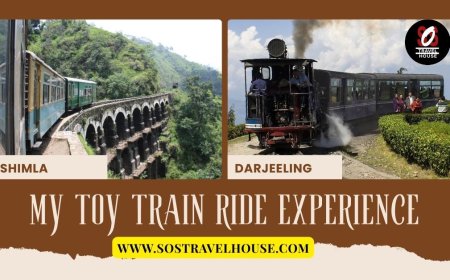How to Plan a Wildlife Trek in Ladakh
Discover essential tips for planning a wildlife trek in Ladakh. Learn about the best time to visit, permits, gear, and top trekking routes.

Trekking in Ladakh offers more than the stunning scenery and mountainous terrainit is also the gateway to India's finest wildlife. In rugged mountains and barren valleys, elusive wildlife like the snow leopard, Tibetan wolf, and blue sheep herds hide. For the adventurer who seeks adventure with a purpose, a Ladakh wildlife trek can be inspiring and exhilarating. Organising such a journey, however, demands meticulous organisation, familiarity with the terrain and climate, and an utmost regard for the tenuous environment that characterises this desert at high elevation.
Selecting the Ideal Trek
Not every Ladakh trek is appropriate for seeing wildlife. If you want to see rare animals in their natural habitat, you must go on treks that pass through areas that are rich in wildlife.
The snow leopard trek, normally accomplished in winter, is the most iconic. It is conducted in Hemis National Park, or the snow leopard capital of the world. The trek offers a once-in-a-lifetime opportunity to see the 'ghost of the mountains' inhabit their snowy realm.
Other wildlife trails are Rumbak Valley and Ulley trails, which are areas that provide good prospects of animal sightings. Depending on the pace, difficulty, and trail, the treks usually last anywhere from six to twelve days.
Best Time for a Ladakh Wildlife Trek
The period of the year your trek occurs in is rather decisive as far as wildlife spotting is concerned. The snow leopard trek usually happens between late November and March. It is during this time that snow drives the prey species, such as the bharal (blue sheep), down to lower altitudes, and then predators such as snow leopards trail behind.
If you prefer drier conditions, summers from May to September are better. Snow leopards are not as easy to spot during this time, but you can glimpse marmots, Himalayan foxes, and migratory birds that move up to high-altitude wetlands.
Do not forget that the high altitude of Ladakh can make the weather unreliable even during summer. Be prepared at all times for sudden temperature drops, snow, or gusty winds.
Physical and Mental Preparation
A Ladakh wildlife trek is for the adventurous. The altitudes are between 3,500 and more than 5,000 metres. Acclimatisation is necessaryspend a minimum of two days in Leh prior to the trek. AMS symptoms include headaches and nausea, up to dizziness and fatigue. Rest, hydration, and slow movement reduce these symptoms.
More endurance is needed for winter treks, especially those that involve snow leopards. It could get as low as -20C at night. Layered clothing, thermal apparel, and high-quality sleeping bags are essential. Trekkers have to mentally prepare for hours of walking, waiting, and observing in the most inclement weather.
Packing Essentials
For a snow leopard trek, the right equipment can prove to be the key. Apart from warm clothing and trekking shoes, pack:
-
Down jacket and windproof outerwear
-
Sunglasses and sunblock
-
Insulated water bottle
-
Binoculars and a decent camera for animal spotting
-
Headlamp and spare batteries
-
Medication of personal use and a basic first aid kit
Porters and ponies prove to be good during winter, but trekkers need to keep their priority gear with them in a daypack. Travel light but don't skimp.
Respecting the Ecosystem
Moral conduct is needed when wildlife trekking. Keep at a safe and respectful distance from wildlife at all times. Avoid loud noises, sudden gestures, and littering.
Avoid feeding and tempting wildlife. This puts humans and animals at risk and messes with their natural behaviour. To reduce environmental impact and erosion, use ground trails.
Practice leave-no-trace while camping. Dispose of waste properly. Stay at homestays in villages whenever possible to contribute to the community without putting pressure on the environment.
Learning about the Role of Local Guides
It's not only recommended, but sometimes mandatory, to employ veteran local guides. Entrance permits or passes might be needed by most sites, which guides can book. Their knowledge of terrain, animal habits, and following is well worth the money, as it enhances your chances of a good sighting significantly.
In addition, guides help you remain safe. In cold winter conditions where paths disappear under snow, their familiarity with the terrain is a valuable resource.
Cultural Sensitivity
Ladakh villages are of Tibetan Buddhist origin. While you travel along Rumbak or Ulley, respect the villagers. Dress modestly, seek permission to take pictures, and don't enter sacred sites without a guide.
Learning a few of the regional idioms can help you communicate effectively. Connections are made even when you say "Jullay" (hello, thank you, good-bye).
The blending of religion and nature in Ladakhi culture. Wildlife is often revered as holy. Enjoyment of this relationship adds depth to the meaning of your trek.
Insurance and Permits
Before embarking on a Ladakh wildlife trek, ensure you are covered for high-altitude trekking and emergency evacuation with your travel insurance. Helicopter evacuations are possible but are extremely expensive without adequate cover.
You shall require permits for the Hemis National Park and other protected zones. If your trek passes through border zones, such as Nubra or Changthang, you will also require Inner Line Permits. Your guide or tour organiser will usually arrange for these details.
Remaining Safe and Healthy
Altitude apart, trekkers must be careful against dehydration, sunburn, and frostbite. Carry purification tablets if the drinking water is not clean. Avoid alcohol throughout the trek since it increases the vulnerability to AMS.
Don't overexert yourself. Split your trip into sensible legs and listen to your body. Dealing with sickness, speak to your guide and don't refuse to rest or come down.
A Note on Dream Land
For those who are still pondering where to begin, Dream Land offers a comprehensive trekking experience based on years of navigating the hostile terrain of the area. They work extensively with local trackers and homestays, particularly in snow leopard ecosystems like Ulley and Rumbak. Not excessively commercial in their outlook, but selectively designed treks ensure safety along with an enthusiastic wildlife experience. Many seasoned hikers and photographers have used their logistical skills to lead remote wildlife expeditions and successful snow leopard treks.
They are an outward-looking company with a philosophy of sustainability, cultural respect, and genuine immersion, making them a safe pair of hands for both beginners and veteran travellers alike.
Final Thoughts
A Ladakh wildlife trek is not only a physical challengeit's a rare chance to view some of the most remote and unspoiled habitats on the planet. Whether you have a fantasy about a snow leopard sighting or simply want to observe Himalayan wildlife in its natural state, care and planning are critical.
Respect the country, listen to local wisdom, and walk lightly. The cold may sting, and paths may be tough, but memories of an encounter with wildlife in Ladakh's otherworldly landscape will haunt your mind for a lifetime.



























